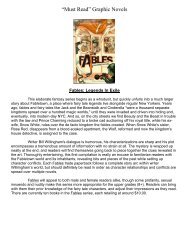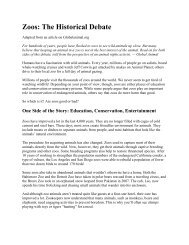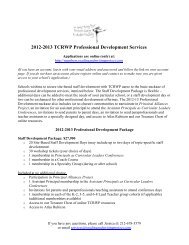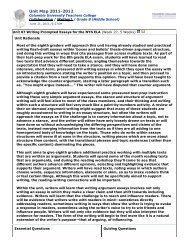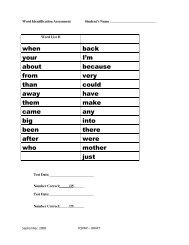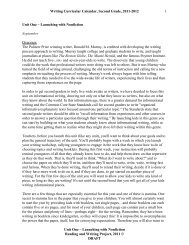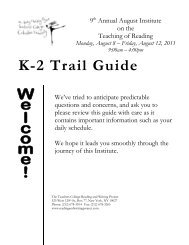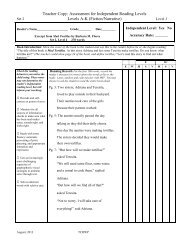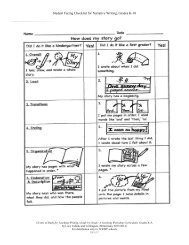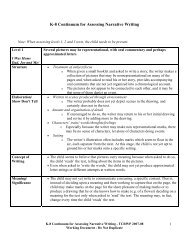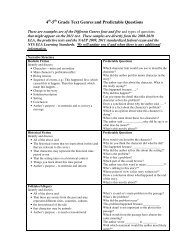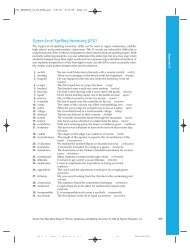Continuum for Information Writing â Third Grade S tru cture
Continuum for Information Writing â Third Grade S tru cture
Continuum for Information Writing â Third Grade S tru cture
- No tags were found...
Create successful ePaper yourself
Turn your PDF publications into a flip-book with our unique Google optimized e-Paper software.
<strong>Grade</strong> 1(1 points)1.5pts<strong>Continuum</strong> <strong>for</strong> In<strong>for</strong>mation <strong>Writing</strong> – <strong>Third</strong> <strong>Grade</strong>Updated 11/12/12<strong>Grade</strong> 2(2 points)2.5pts<strong>Grade</strong> 3(3 points)3.5pts<strong>Grade</strong> 4(4 points)ScoreOverallI taught my readersabout a topic.I taught readers someimportant points abouta subject.I taught readersin<strong>for</strong>mation about asubject. I put in ideas,observations, andquestions.MidlevelMidlevelMidlevelMy writing teaches readersdifferent things about a subject.I put facts, details, quotes, andideas into each part.S<strong>tru</strong><strong>cture</strong>LeadTransitionsEndingIn the beginning, Inamed my topic andgot my reader’sattention.I told different partsabout my topic ondifferent pages.I wrote an ending.In the beginning, Itried to interest readersand to tell them whatmy piece is about.I let used words likeand, also to show Ihad more to sayI wrote somesentences or a sectionat the end to wrap upmy piece.My beginning getsreaders ready to learn a lotof in<strong>for</strong>mation about thesubject.I used words to showsequence like be<strong>for</strong>e, after,then, later. I also usedwords to show what didn’tfit like however and but.I wrote an ending thatdraws conclusions, asksquestions, or suggestsways readers mightrespond.MidlevelMidlevelMidlevelMidlevelMidlevelMidlevelMidlevelMidlevelMidlevelI hooked my reader byexplaining why the subjectmatters, telling a surprisingfact, or giving a big pi<strong>cture</strong>. Ilet readers know that I willteach them different thingsabout the subject.I used words in each sectionthat help the reader understandhow one piece of in<strong>for</strong>mationconnects with others. If thesection is written in sequence, Iused words such as be<strong>for</strong>e,later, next, then, after. If thesection is organized in kinds orparts, I used words such asanother, also, <strong>for</strong> example.My ending reminds readers ofmy subject and may suggest afollow-up action, or leave themwith a final insight. I added mythoughts, feelings, ideas orquestions about the subject atthe end.(Elaboration and Description are double weighted categories. Whatever score a student would get in these categories is worth double the amount of points. Ex. if a student exceeds expectations in Elaboration, then thatstudent would receive 8 points instead of 4 points. If a student meets standards in Elaboration, then that student would receive 6 points instead of 3 points, and so on.)©Units of Study <strong>for</strong> Teaching <strong>Writing</strong>, <strong>Grade</strong> by <strong>Grade</strong>: A Yearlong Workshop Curriculum, <strong>Grade</strong>s K-8,by Lucy Calkins and Colleagues (Heinemann, 2013/2014)For distribution only in TCRWP schools
OrganizationI told about my topic,part by part.<strong>Continuum</strong> <strong>for</strong> In<strong>for</strong>mation <strong>Writing</strong> – <strong>Third</strong> <strong>Grade</strong>Updated 11/12/12My writing hasdifferent parts. Eachpart tells differentin<strong>for</strong>mation about thetopic.I grouped my in<strong>for</strong>mationinto parts. Each part of ismostly about one thingthat connects to my bigtopic.MidlevelMidlevelMidlevelI grouped in<strong>for</strong>mation intosections and used paragraphsand sometimes chapters toseparate sections. Each sectionhas in<strong>for</strong>mation that is mostlyabout the same thing. I mayhave used headings andsubheadings.TotalElaboration<strong>Grade</strong> 1(1 points)I put facts in mywriting to teach peopleabout my topic.1.5pts<strong>Grade</strong> 2(2 points)I used different kindsof in<strong>for</strong>mation likefacts, definitions,details, steps, tips.2.5pts<strong>Grade</strong> 3(3 points)I wrote facts, definitions,details, observations aboutmy topic and explainedsome of them.3.5ptsMidlevelMidlevelMidlevel<strong>Grade</strong> 4(4 points)I taught my reader differentthings about the subject. I chosethese subtopics because theyimportant and interesting.ScoreDevelopmentI included different kinds offacts and details like numbers,names, and examples.I got my in<strong>for</strong>mation fromtalking to people, reading booksand from my own knowledgeand observations.I made choices aboutorganization. I might have usedcompare/contrast, cause/effector pro/con. I may have useddiagrams, charts, headings, boldwords, and definition boxes tohelp me teach my readers.(x2)(Elaboration and Description are double weighted categories. Whatever score a student would get in these categories is worth double the amount of points. Ex. if a student exceeds expectations in Elaboration, then thatstudent would receive 8 points instead of 4 points. If a student meets standards in Elaboration, then that student would receive 6 points instead of 3 points, and so on.)©Units of Study <strong>for</strong> Teaching <strong>Writing</strong>, <strong>Grade</strong> by <strong>Grade</strong>: A Yearlong Workshop Curriculum, <strong>Grade</strong>s K-8,by Lucy Calkins and Colleagues (Heinemann, 2013/2014)For distribution only in TCRWP schools
<strong>Grade</strong> 1(1 points)1.5pts<strong>Continuum</strong> <strong>for</strong> In<strong>for</strong>mation <strong>Writing</strong> – <strong>Third</strong> <strong>Grade</strong>Updated 11/12/12<strong>Grade</strong> 2(2 points)2.5pts<strong>Grade</strong> 3(3 points)3.5pts<strong>Grade</strong> 4(4 points)ScoreDescriptionI used labels and wordsto give facts.I tried to include thewords that show I’man expert on the topicI chose expert words toteach readers a lot aboutthe subject. I taughtin<strong>for</strong>mation in a way tointerest readers. I mayhave used drawings,captions or diagrams.MidlevelMidlevelMidlevelI made deliberate word choicesto teach my reader. I may havedone this by using andrepeating key words about mytopic.When it felt right to do so, Ichose interesting comparisonsand used figurative language toclarify my points.I made choices about whichin<strong>for</strong>mation was best toinclude/not include.(x2)I used a teaching tone. To doso, I may have used phrases likethat means..., what that reallymeans is..., let me explain...Total<strong>Grade</strong> 1(1 points)1.5pts<strong>Grade</strong> 2(2 points)2.5pts<strong>Grade</strong> 3(3 points)3.5pts<strong>Grade</strong> 4(4 points)ScoreLanguageConventionsSpellingI used all I know aboutwords and chunks(“at,” “op,” “it”…) tohelp me spell.To spell a word, I usedwhat I know aboutspelling patterns(“tion,” “er,” “ly”,etc.)I used what I know aboutspelling patterns to helpme spell and edit be<strong>for</strong>e Iwrote my final draft.MidlevelMidlevelMidlevelI used what I know about wordfamilies and spelling rules tohelp me spell and edit. I usedthe word wall and dictionariesto help me when needed.(Elaboration and Description are double weighted categories. Whatever score a student would get in these categories is worth double the amount of points. Ex. if a student exceeds expectations in Elaboration, then thatstudent would receive 8 points instead of 4 points. If a student meets standards in Elaboration, then that student would receive 6 points instead of 3 points, and so on.)©Units of Study <strong>for</strong> Teaching <strong>Writing</strong>, <strong>Grade</strong> by <strong>Grade</strong>: A Yearlong Workshop Curriculum, <strong>Grade</strong>s K-8,by Lucy Calkins and Colleagues (Heinemann, 2013/2014)For distribution only in TCRWP schools
PunctuationI spelled the WordWall Words right andused the Word Wall tohelp me spell otherwords.I ended sentences withpunctuation.<strong>Continuum</strong> <strong>for</strong> In<strong>for</strong>mation <strong>Writing</strong> – <strong>Third</strong> <strong>Grade</strong>Updated 11/12/12I spelled all of theWord Wall wordscorrectly and used theWord Wall to help mefigure out how to spellother words.I used quotation marksto show what peoplesaid.I got help from others tocheck my spelling andpunctuation be<strong>for</strong>e I wrotemy final draft.I punctuated dialoguecorrectly, with commasand quotation marks.MidlevelMidlevelMidlevelWhen writing long, complexsentences, I used commas tomake them clear and correct.I used a capital letter<strong>for</strong> names.I used commas in datesand listsWhen I used wordslike can’t and don’t, Iput in the apostrophe.While writing, I putpunctuation at the end ofevery sentence.I wrote in ways that helpedreaders read withexpression, reading someparts quickly, someslowly, some parts in onesort of voice and others inanother.TotalTeachers, when this is totally finished, each category will refer to “the writer” rather than “I”. We are giving out these assessments so they can be used immediately, after giving the on demands, andthey can be used with kids <strong>for</strong> self-assessment and setting goals. We have created these continua so you will have your own place to pull together scores of student work.Scoring Guide:In each row, circle the descriptor in the column that matches the student work. Scores in the categories of Elaboration and Description are worth double the pointvalue (2, 3, 4, 5, 6, 7, or 8 instead of 1, 1.5, 2, 2.5, 3, 3.5, or 4).Total the number of points, and track students’ progress by seeing when the total points increase.(Elaboration and Description are double weighted categories. Whatever score a student would get in these categories is worth double the amount of points. Ex. if a student exceeds expectations in Elaboration, then thatstudent would receive 8 points instead of 4 points. If a student meets standards in Elaboration, then that student would receive 6 points instead of 3 points, and so on.)©Units of Study <strong>for</strong> Teaching <strong>Writing</strong>, <strong>Grade</strong> by <strong>Grade</strong>: A Yearlong Workshop Curriculum, <strong>Grade</strong>s K-8,by Lucy Calkins and Colleagues (Heinemann, 2013/2014)For distribution only in TCRWP schools
Total score: ________<strong>Continuum</strong> <strong>for</strong> In<strong>for</strong>mation <strong>Writing</strong> – <strong>Third</strong> <strong>Grade</strong>Updated 11/12/12If you want to translate this score into a grade, you can use the provided table to score each student on a scale from 0 – 4.Number of PointsScaled Score1-11 111.5-16.5 1.517-22 222.5-27.5 2.528-33 333.5-38.5 3.539-44 4(Elaboration and Description are double weighted categories. Whatever score a student would get in these categories is worth double the amount of points. Ex. if a student exceeds expectations in Elaboration, then thatstudent would receive 8 points instead of 4 points. If a student meets standards in Elaboration, then that student would receive 6 points instead of 3 points, and so on.)©Units of Study <strong>for</strong> Teaching <strong>Writing</strong>, <strong>Grade</strong> by <strong>Grade</strong>: A Yearlong Workshop Curriculum, <strong>Grade</strong>s K-8,by Lucy Calkins and Colleagues (Heinemann, 2013/2014)For distribution only in TCRWP schools



